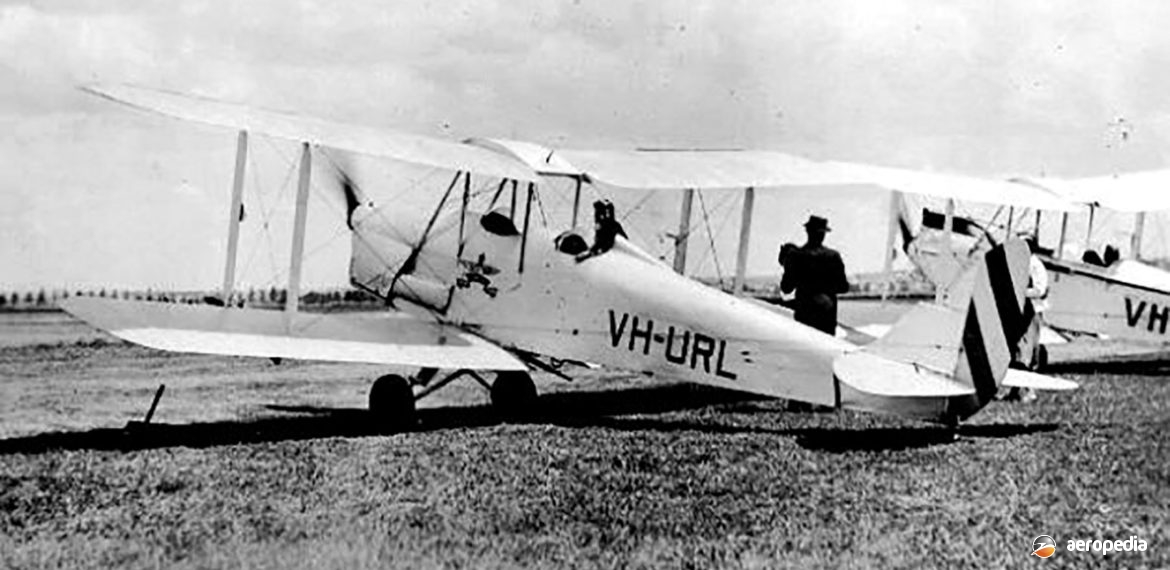Photograph:
de Havilland DH.60G-III Moth Major VH-URL (c/n 5052) (Eddie Coates collection)
Country of origin:
United Kingdom
Description:
Two-seat touring and training biplane
Power Plant:
One 90 kw (120 hp) de Havilland Gipsy III four-cylinder in-line air-cooled engine; or
One 96 kw (130 hp) de Havilland Gipsy Major four-cylinder in-line inverted air-cooled engine
Specifications:
- Wingspan: 9.75 m (32 ft)
- Length: 9.29 m (23 ft 11 in)
- Height: 2.71 m (8 ft 9½ in)
- Wing area: 22.57 m² (243 sq ft)
- Max speed: 174 km/h (108 mph)
- Cruising speed: 148 km/h (92 mph)
- Initial rate of climb: 272 m/min (892 ft/min)
- Ceiling: 5,715 m (18,750 ft)
- Range: 515 km (320 miles)
- Empty weight: 456 kg (1,005 lb)
- Loaded weight: 794 kg (1,750 lb)
History:
In the late 1920s de Havilland was working towards the development of a light four-cylinder in-line engine for aviation use and in 1931 designed a new variant of the upright Gipsy III engine which ran inverted. This was installed in a new variant of the DH.60 Moth, which became known as the DH.60G-III Moth Major. This new model of the series had an all-wood fuselage and the inverted engine permitted a streamline cowling which followed the smooth lines of the fuselage.
The prototype G-ABVW (c/n 5003) was shown to the public in March 1932 and was followed by a single-seat version with an experimental Gipsy III engine, this model being destined to be flown by Hubert Broad in the 1932 King’s Cup Race at a speed of 211.36 km/h (131.34 mph). In July 1932 British aviatrix Amy Mollison had a Gipsy III engine installed in her standard DH.60 Moth. Eventually the Gipsy IIIA engine was placed in production and became known as the Gipsy Major.
The DH.60G-III was put into production for aero club and private use. The first 57 airframes were delivered with the Gipsy III engine which provided 90 kw (120 hp) and were mainly for private use. Subsequent aircraft were fitted with the 96 kw (130 hp) Gipsy Major engine, and becoming known as the DH.60G-III Moth Major. Production continued until May 1935, ten airframes being diverted for conversion to radio controlled Queen Bee configuration. A couple of earlier Moths, including VH-UMO, were re-engined with the Gipsy III or Gipsy Major engine. Total production of the Moth Major was 154 aircraft.
Examples registered in this region included: VH-URR (c/n 5085) which was built with a Gipsy Major engine and was registered to the Newcastle Aero Club. It was damaged a couple of times in heavy landings on 7 April 1935 and 25 January 1937. It was later impressed by the RAAF in July 1940 as A7-90.
VH-URS (c/n 5086) was built with a Gipsy Major engine and was registered to Messrs J J Masse and G R Vaughan on 5 September 1934. Later owners included C H Young of Cunnamulla, QLD and the Newcastle Aero Club. It was impressed by the RAAF as A7-91 in July 1940.
VH-URL (c/n 5053) was built with a Gipsy Major engine and was registered in March 1934 but had an accident on 2 April 1934. It was repaired.Owners included the Queensland Aero Club. It was impressed by the RAAF as A7-82 in July 1940 for training duties.
VH-UUC (c/n 5084 – ‘Christopher Robin’) was built with a Gipsy Major engine and, as G-ACUC, was flown to Australia from Lympne, Kent in England by Freda Thompson. It was sold to the Broken Hill Aero Club and operated in western NSW until the registration lapsed on 23 April 1941.
The DH.60G-III Moth Major was also operated in New Zealand, six examples being gifted to aero clubs by the New Zealand Government for pilot training in the 1930s. They were impressed by the RNZAF during World War II, being attached to No 2 Flying Training School (FTS). Used in the training role, they suffered a number of accidents and none has survived.
Their histories are: ZK-ADK (c/n 5114) was operated by Hawkes Bay and East Coast Aero Clubs, being impressed as NZ508 and written off in 1941.
ZK-ADL (c/n 5115) was operated by the Wairarapa & Ruahine Aero Clubs before being impressed as NZ521. It ended its days as Instructional Airframe 25.
ZK-ADM (c/n 5118) was operated with Southland Aero Club until impressed as NZ515 . It crashed and was written off in 1940.
ZK-ADO (c/n 5120) was operated by the West Coast Aero Club and crashed at Waiho in 1935.
ZK-ADP (c/n 5121) was operated by the Wellington Aero Club and was impressed as NZ503, later becoming Instructional Airframe 47.
In New Zealand Gregory ‘Stan’ Smith during 2019 commenced reverse engineering the wreck of a de Havilland DH.82A Tiger Moth ZK-AQA which had been involved in an accident on 27 January 1965. Mr Smith was of the opinion that the forerunner of the DH.82A was the DH.60M-III, which was to have a metal airframe as compared to the wooden airframe of the DH.60G-III, which was mooted but never built, and not the DH.60T as has been popularly thought. When completed to DH.60M-III configuration the aircraft would be the first of the model constructed, de Havilland not building the type but moving on to the DH.82. The work has been carried out at Auckland’s North Shore aerodrome.

